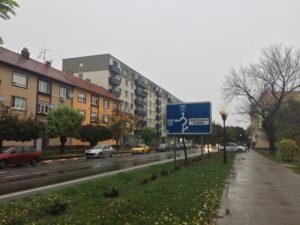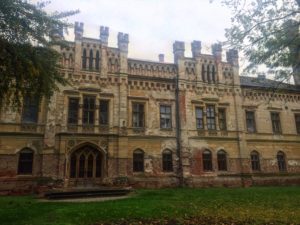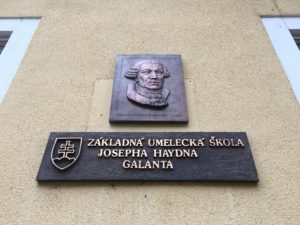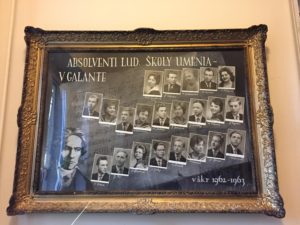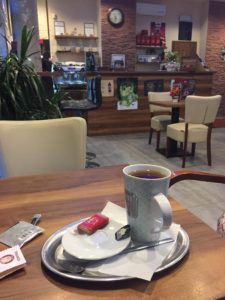Musical Adventures: Day Trip to Galánta
Living in Europe the last few years has given me the incredible opportunity to travel to some pretty amazing places. Having visited 30 countries (and counting!), I’ve been able to explore bustling metropolises, rural villages, quiet cemeteries, dusty archives, and other portals to the past.
I have always loved history. Not only did I read my Norton music history textbook for fun, but I also contacted the publishers to report a few errors (they listed Bernstein’s birth year as 1916!). I think it is important to understand our musical past so we can continue to grow as musicians, and I welcome any opportunity to experience history firsthand.
During my travels, I always plan my itinerary around places, people, and events particular to music history. My first stop in Vienna was the Zentralfriedhof to hang with the ghosts of Brahms, Beethoven, Schubert, et al. Instead of taking the airport shuttle directly to Stockholm, I stopped in Solna to visit Crusell’s grave at Norra begravningsplatsen. I stumbled off my red-eye flight to Amsterdam to hear a concert at the Concertgebouw. I spent an entire afternoon at the British Library examining a manuscript of Stravinsky’s Three Pieces. I even snuck into Saint-Merry in Paris once just to see the organ that Saint-Saëns played.
One of my favorite musical adventures was visiting Galánta, the namesake town of Zoltán Kodály’s famous Dances of Galánta. Galánta is small town in present-day Slovakia, roughly 50 kilometers east of Bratislava. Zoltán’s father Frigyes worked at the Galánta train station, and Zoltán spent his childhood years here (when it was part of Hungary). The young Zoltán was inspired by the music of the traveling gypsy bands that visited Galánta. Although Kodály later traveled and collected musical excerpts from around the country, the musical inspiration for Dances of Galánta was not derived from these ethnomusicological pursuits. Kodály was inspired by a volume of Hungarian folk music published in Vienna around the turn of the 19th century.
Clarinetists should be well-versed in Dances of Galánta, as it is one of our most standard orchestral excerpts. The clarinet cadenza at the beginning of the piece transports us to another time and place. We are raised dissecting the musical minutiae – the musical syntax and its reflection of the Hungarian language; emphasis on the proper syllables to communicate the verbunkos style; proper energy to communicate the ethnic dance styles.
Needless to say, I jumped at the opportunity to visit Galánta during a recent trip throughout Eastern Europe.
After arriving to Bratislava and grabbing a quick bite to eat (some amazing vegan schnitzel and potato salad at Re:Fresh, if you’re interested), I hopped on a train to Galánta. I spent the 45-minute journey listening to the piece that prompted this trip, imagining the traveling gypsy bands, quaint rural town, and quelling the excitement at finally seeing the town that sparked Kodály’s imagination.
I was a bit disappointed to find that the town was just…a town…There were no signs or statues commemorating Kodály or his music, minus a street named in his honor. Despite the persistent rain, I set off to explore Galánta.
Half pseudo-musicologist, half tourist, I visited several shops and cafés, hoping to find remnants of the past. Unfortunately, many buildings were destroyed during World War II, and many more were rebuilt as bland concrete structures during the Communist era of Czechoslovakia. The incessant rain made this architecture even more bleak. Undeterred, I visited the shops at the center of town, where I bought some organic Hungarian tea at a health store and perused the local Lidl to escape the rain.
Two important structures in Galánta still stand today – the Esterházy’s Neo-Gothic Castle (which is closed to the public) and the Renaissance Castle (which is used as a museum and cultural center). I visited both before continuing to my main destination – the Základná umelecká škola Jozefa Haydna, or Joseph Haydn Music School.
The Haydn Music School of Galánta is a small three-story building next to the Esterházy castle. I entered the school (attracting many confused glances from the students) and studied the plaques of former graduating classes. One name in particular caught my eye – V. Rózsa in the photo from 1962-1963 – perhaps a relative to Miklós?
After sufficiently exploring the music school, I returned outside to the steady drizzle. Because I had been exploring a few hours by now, I had seen most of what Galánta has to offer. I warmed up with some tea at a small cafe near the train station as the locals clouded the interior with cigarette smoke (smoking indoors is a rarity even in Europe!).
Galánta is an authentic and modest town. It is easy to imagine Kodály’s humble beginnings here. Its proximity to other capital cities such as Bratislava and Vienna must have allowed him to hear several traveling bands and musicians. I am sure much of Galánta’s quaint charm was lost during and after WWII as the town became more commercialized. Although I didn’t encounter any traveling gypsy bands, street musicians, or any obvious hommage to Kodály, I was not disappointed by my visit. Galánta’s humble authenticity still sparked my imagination. It had not been lost to tourism, and its architecture reflected its tumultuous history throughout the 20th century. Locals were polite and helpful, and they didn’t stare too much as I took selfies with street signs and other Galánta landmarks.
I am so glad that I had the opportunity to visit Kodály’s roots and explore the town that inspired such a masterpiece of orchestral literature. I have a much deeper understanding and appreciation for Dances of Galánta, and my travels will certainly help shape my interpretation of the clarinet cadenzas (although I wish it could do something to help with the altissimo notes on the last page!)


